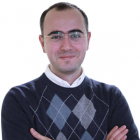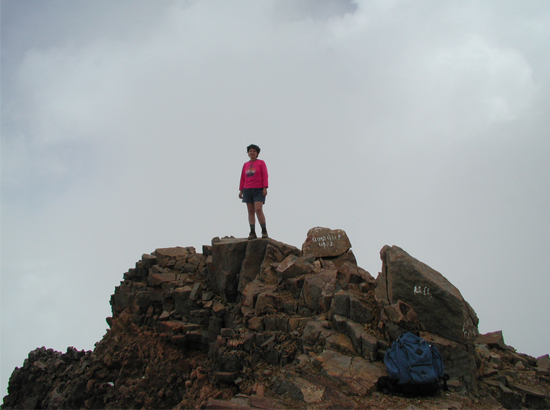Anahid is a Particle Accelerator Physicist at the Stanford Linear Accelerator Center (SLAC) in Stanford, California. Prior to this, she had worked at Boeing for many years.
My parents are immigrants. My mother’s family immigrated to Armenia in 1948 from the United States, and my father’s family – in 1946 from Beirut, Lebanon. My mother always wanted to return to USA. When the Soviet “doors” partly opened in 1960s, our family asked for a permission to leave for USA. In 1968, we received the permission and left for Philadelphia where mother’s relatives lived. I was 14 years old back then. We took a big library with us: Raffi’s works, “Mkhitar Sparapet”, “Vardanank” and many others. We lived in the suburb of Philadelphia, where I finished the school and University.
We met with Anahid in Yerevan this summer. Before that we have communicated only via e-mails, mainly in English. I knew that she had been living in America for already several decades, and approaching her house I was expecting to see a typical woman from the Diaspora. But when Anahid walked out of the nearby shop and approached me, it seemed to me that she had never left Yerevan. She looked like a real Yerevanian - the clothing, the manner of speech, the behavior. She bought some fruits and sweets.
It’s deeply etched in my mind that wherever I am, I have to live in harmony with the given environment. As Apostle Paul says in the Holy Book: "When in Rome, do as the Romans do…". When we came to the US, I tried to behave like an American, paying attention to all the details, even to how my classmates were pulling a paper out of the notebook. I paid attention to my accent, trying to make it sound more American. Wherever I am, I am trying to be like a local everywhere. Things are much easier in Armenia. When I was in Armenia in 1999, I took our neighbor’s baby for a walk to eat an ice cream. The ice cream seller told me: “I thought you were a local.”
Anahid attended Drexel University in Philadelphia and graduated with a Bachelor’s Degree in Physics.
We had a very interesting program at the University: the students studied 5 years instead of 4. During these years they attended the University for 6 months and worked for the rest 6 months. The University gave a chance to students to work. It did not provide work but promised to schedule several interviews. I had one interview and was invited to work in one of the labs. During last 6 months I was working on an accelerator and was later invited to work there after graduating from the University, and I was happy to accept the proposal. In fact, I have never looked for another job after this interview at my first year at the University.
After Washington, Anahid has worked for one of American economy giants for over 10 years – Boeing.
One day, a representative of Boeing Corporation visited our lab. They had a particle accelerator and they cooperated with our lab. My Director was on a meeting and asked me to receive the visitor. He asked me whether I wanted to work at Boeing. I have never been to the West Coast before and I thought I could go to an interview. There is Mount Rainier in Seattle. It’s like the copy of Mount Ararat. It’s always cloudy there. But I was lucky that day and the sun was shining and when I saw the Mount, I made up my mind. I consulted with my Director and he said I had made the right decision. 
Mount Rainier.
Photo – Linda Aaaron.
I have worked at Boeing for about 11 years. Then I received in invitation from Stanford. They were trying to launch a 3 km-long linear accelerator and invited me to work on it. I have been working there for already 22 years.
I also worked at CERN- the European Organization for Nuclear Research as an invited scientist. Our Stanford laboratory collaborated also with the High Energy Accelerator Research Organization (KEK) of Japan.
Working at the most renowned modern scientific centers and being well familiar with their possibilities and potential, Anahid believes that the Armenian science also has future if it receives relevant attention from country’s authorities.
Armenia is a small country experiencing a lot of difficulties, tough neigbours, closed borders. Even in such conditions 5-10% of the budget should be allocated to science, because science creates possibilities for business. When the US scientists were making efforts, they never thought that the Silicon Valley would be ever created. Science made USA a global leader.
In 1999, Anahid and her father decided to visit Armenia. She says it was at that time when she was re-born as an Armenian. After that visit, she arrives in Armenia at least twice a year. 
Anahid Yeremian in Sardarapat.
Photo – from Anahid Yeremian’s archive.
When I climbed up Mount Aragats for the first time, near the Stone Lake I saw the buildings of Cosmic Ray Division of the Armenian Physics Institute. I decided to go there. I met the head of the Division Professor Ashot Chilingaryan there, who is currently the Director of Physics Institute. He showed me the equipment and told me about the developments in Armenia and in the world. I was greatly surprised, because he knew about studies in cosmic-ray physics at Stanford better than me. When I saw their outdated computers, I thought it was impossible to work on them. But they were moving forward along with the whole world with almost zero-budget. They worked almost without salaries. Peasants helped them, bringing fruits and vegetables from their gardens. I was deeply impressed by what I saw there.
During one of conferences I met many foreign specialists who were interested in such projects. During my previous visit to Armenia, I told Professor Chilingaryan that Canadian specialists were interested in cooperation. And it’s been already 13 years that I have been trying to help them as much as I can. I know, if Ashot Chilingaryan is given a chance, he always doubles it. All interested individuals can support the Cosmic Ray Division of the Armenian Physics Institute through this website - http://www.crdfriends.org.
Anahid says she is not a big scientist.
Scientists working on accelerators describe themselves as “slaves of scientists”. We develop accelerators according to the laws of physics, in line with requirements of those physicians who want to discover something new. For example, they want to know whether there exists a new particle or not, what charge it has. We design new machines. I am not a discoverer-scientist.
Scientists are also analysts; they can find links and draw conclusions. This is how I can describe myself. It refers not only to science but also to the rules of life. I talk to various people - taxi drivers, scientists, journalists, peasants - and I draw up a picture in my mind of how Armenia develops and in what direction.
Anahid and the Armenian students at Stanford have worked out a program called “Act for Armenia” in 2003.
Thanks to this program 5 border villages and one village on Aragats receive aid, for example school textbooks and stationary.
There is a remote village in Armenia on the border with Azerbaijan - Aghbradzor. It has a small school. The director of the school is Ginevard Ghukasyan, a well educated woman, who could easily find a job in Yerevan. But she decided to stay in her home village with her family and educate children. Last year a student from Santa Barbara Nanor Balabanyan presented computer equipment to the school. Her initiative is called “The Hidden Road imitative” and this is their website - http://www.hiddenroadinitiative.com.
This summer Anahid and her friends organized a bicycle tour in Armenia and Artsakh.
The tour was organized to support the Cosmic Ray Division of Physics Institute. Three years ago, I met Vache Soghomonyan, who organizes such campaigns to support the peasants: he has been doing it for already 10 years. He advised to organize a bicycle tour to support scientists. 
Anahid Yeremian with the participants of cycle campaign in Stepanakert.
Photo- from Anahid Yeremian’s archive.
Anahid says her parents and her brother’s family are the most important things in her life.
My parents made big sacrifices so that I and my brother could succeed in life. They lost everything they had. For the first time my grandparents lost everything during the Genocide, and for the second time - after the repatriation. During the Stalin’s regime, they lost everything and began life from scratch. Then they were forced to do it for the third time, when we left for the USA. We sold our property, but the Soviet authorities did not allow taking much money abroad. So, we had only $500 when we were leaving for the USA.
My grandmother used to say: “They can take everything from you but not your knowledge”. Never say no to knowledge, even if you think it is inappropriate at that moment. She also used to say: “Learn, put knowledge into your pocket. One day you’ll need it.” These words have always given me strength. I follow this motto and I am trying to teach this to my nephews.
Ara Tadevosyan talked to Anahid Yeremian.


















Comments
Dear visitors, You can place your opinion on the material using your Facebook account. Please, be polite and follow our simple rules: you are not allowed to make off - topic comments, place advertisements, use abusive and filthy language. The editorial staff reserves the right to moderate and delete comments in case of breach of the rules.